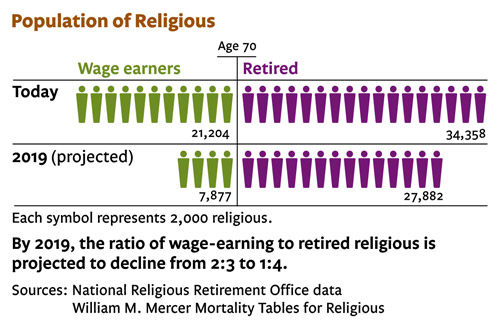Originally known as the Tri-Conference Retirement Office, the National Religious Retirement Office (NRRO) was established in 1986 to address the significant lack of retirement savings among religious communities in the United States. The NRRO coordinates the annual collection for the Retirement Fund for Religious and distributes the proceeds to help religious institutes address current and future retirement needs. Despite the overwhelming generosity to this collection, the needs of elder religious remain profound. Escalating the concern is the expected shift in the ratio of wage-earning members to those who are retired. Currently, the income of religious in compensated ministry bridges a significant portion of the retirement funding gap, but in the coming years that will no longer be the case.
- In 1987, the cost of living for women and men religious was $9,948 and $10,908 respectively.
- The average cost of independent living for religious today is $28,399.91.
- Since 1988, the Retirement Fund for Religious has received $617 million in donations.
- The cost of living in 2009 for nearly 35,000 women and men religious who are 70 or older exceeded $1 billion.

| 1972 |
U.S. legislators permit religious to enroll in Social Security. |
|
1981 |
Task Force on Religious Retirement surveys retirement financial crisis of religious institutes nationally. |
|
1985 |
First religious retirement needs survey conducted by Arthur Andersen. |
|
1986 |
Wall Street Journal
article and Arthur Andersen Report raise public awareness about retirement needs. |
|
1987 |
Lilly Endowment funds data collection and retirement planning services to all religious institutes. |
|
1988 |
First Retirement Fund for Religious annual national appeal. |
|
1994 |
Collaborative Viability Project begins training consultants to work as teams to assist religious institutes to assess viability and vitality. |
|
1995 |
Council of Major Superiors of Women Religious (CMSWR) joins Leadership Conference of Women Religious, Conference of Major Superiors of Men and National Conference of Catholic Bishops in sponsorship of (renamed) National Religious Retirement Office (NRRO). |
|
2001 |
Cost of nursing home care in U.S. reported to have doubled since 1985. |
|
2002 |
Collaborative Viability Project explores new methods and tools for institutes' use in self-evaluation. |
|
2003 |
NRRO sponsors first of its kind meeting of representatives of Inter-Congregational Retirement projects in St. Louis. Participants include representatives of 12 projects. |
|
2004 |
Mercer Human Resources Consulting conducts actuarial study and assessment of need. Projects $8 billion unfunded liabilities by 2023. |
|
2005 |
NRRO begins e-mail publication Engaging Aging. |
|
2006 |
U.S. bishops extend annual RFR appeal. |
|
2008 |
Total annual cost of support for elder religious in the United States exceeds $1 billion for the first time (based on an average cost of care of $35,000 per person for women and men religious age 70 and over). |
|
2009 |
NRRO adjusts distribution formula for Direct Care Assistance to calculate more objectively a religious institute’s assets available for retirement needs. NRRO replaces the Special Assistance and Supplemental Grants with a pilot project of Planning and Implementation Assistance designed to provide more intensive consultation services for significantly under-funded religious institutes. Supplemental Identified Need Grants are renamed as Management and Continuing Education Assistance. |
